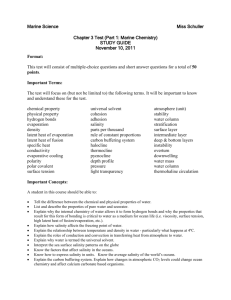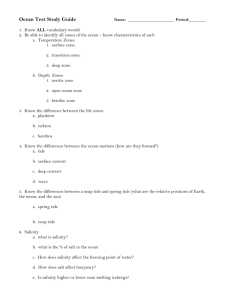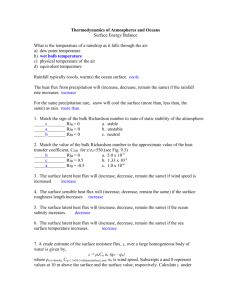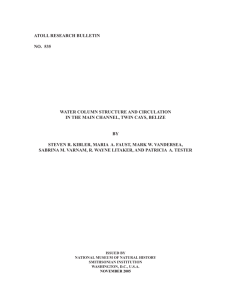Marine Science
advertisement
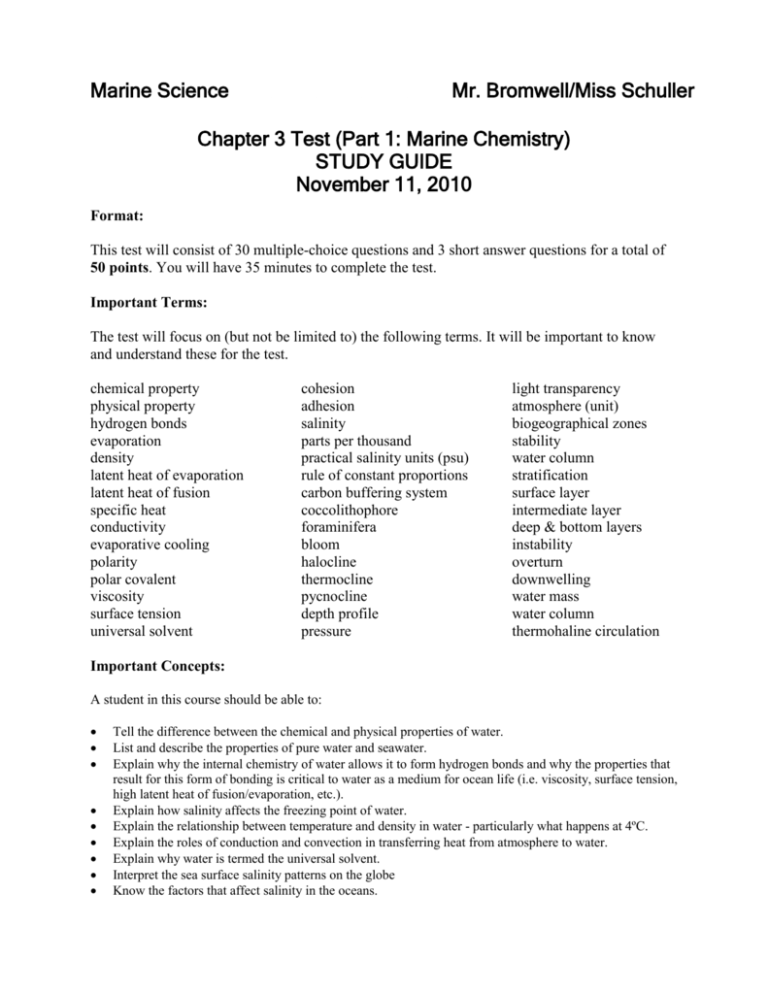
Marine Science Mr. Bromwell/Miss Schuller Chapter 3 Test (Part 1: Marine Chemistry) STUDY GUIDE November 11, 2010 Format: This test will consist of 30 multiple-choice questions and 3 short answer questions for a total of 50 points. You will have 35 minutes to complete the test. Important Terms: The test will focus on (but not be limited to) the following terms. It will be important to know and understand these for the test. chemical property physical property hydrogen bonds evaporation density latent heat of evaporation latent heat of fusion specific heat conductivity evaporative cooling polarity polar covalent viscosity surface tension universal solvent cohesion adhesion salinity parts per thousand practical salinity units (psu) rule of constant proportions carbon buffering system coccolithophore foraminifera bloom halocline thermocline pycnocline depth profile pressure light transparency atmosphere (unit) biogeographical zones stability water column stratification surface layer intermediate layer deep & bottom layers instability overturn downwelling water mass water column thermohaline circulation Important Concepts: A student in this course should be able to: Tell the difference between the chemical and physical properties of water. List and describe the properties of pure water and seawater. Explain why the internal chemistry of water allows it to form hydrogen bonds and why the properties that result for this form of bonding is critical to water as a medium for ocean life (i.e. viscosity, surface tension, high latent heat of fusion/evaporation, etc.). Explain how salinity affects the freezing point of water. Explain the relationship between temperature and density in water - particularly what happens at 4ºC. Explain the roles of conduction and convection in transferring heat from atmosphere to water. Explain why water is termed the universal solvent. Interpret the sea surface salinity patterns on the globe Know the factors that affect salinity in the oceans. Know how to express salinity in units. Know the average salinity of the world’s oceans. Explain the carbon buffering system. Explain how changes in atmospheric CO2 levels could change ocean chemistry and affect calcium carbonate based organisms. Explain how the parameters of density, temperature, light, salinity, dissolved oxygen, and pressure change with depth. Interpret a profile of a water column (Fig. 3.8, Fig. 3.13, Fig. 3.15, and Fig. 3.16 and those distributed on the PowerPoint and handouts.) Know the differences between the seasonal and main thermoclines. Understand how biogeographical zones influence seasonal patterns in the ocean. Explain the pattern of light absorption in the ocean. Which colors are absorbed first? Extend deepest? How does light absorption affect the location of euphotic zones, disphotic zones, aphotic zones, and oxygen minimum zones? Explain the effects of pressure on deep sea animals that are brought to the surface. Explain the pattern of dissolved oxygen in the ocean and what causes this pattern. Describe the conditions that lead to stratification. Describe the characteristics of a water column that is stable and one that is unstable. Understand how density differences in the ocean drive global thermohaline circulation (the great ocean conveyor). Explain the difference between up- and down-welling. What drives/causes each?

